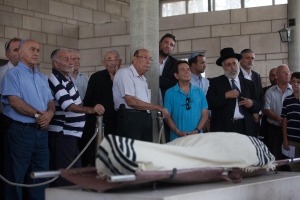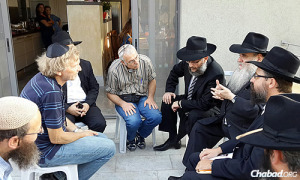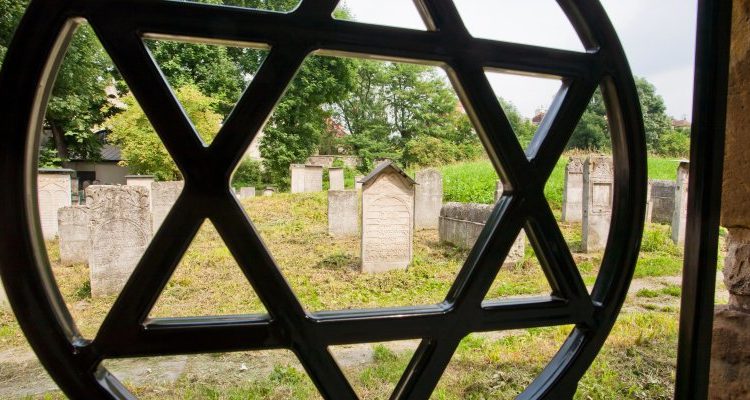In part two of our series “The Jewish Way in Death and Mourning,” we focus on the funeral and the mourning process in the week following death.
Upon receiving the news of the passing of a close relative, the following blessing is recited: “Blessed are You, Lord, our God, King of the universe, the True Judge.”
Mourners are required to tear an outer garment either before the funeral or immediately after it. The tear should be on the left side for a parent, and on the right side for siblings (including half-brothers and half-sisters), children, and spouses.
The Jewish Funeral

The funeral of Israeli politician David Glass in Jerusalem. (Photo: Flash90)
The Jewish funeral consists of a funeral service followed by burial, also known as an interment. Cremation is not acceptable. Embalming is also forbidden. Flowers are usually not found at a traditional Jewish funeral, at least not at the funeral home. Prayers are recited and eulogies are delivered at the funeral service. In the case of a prominent individual, the funeral service might be held, or begin, at a synagogue or a yeshiva. If the funeral service begins at a point other than the cemetery, the entourage accompanies the body in a procession to the cemetery.
Burial should take place as soon as possible after death. Indeed, the Torah requires burial as soon as possible, even for executed criminals. Nevertheless, burial can be delayed “for the honor of the deceased,” such as to allow out of town relatives to arrive. It is extremely unusual for burial to be delayed more than 72 hours after death. In traditional funerals, the casket will be carried from the hearse to the grave in seven stages. These are accompanied by seven recitations of Psalm 91.
When the cemetery component of the service has ended, the mourners come forward to fill the grave. Symbolically, this gives the mourners closure as they observe the grave being filled in. There is a widespread custom at Jewish burials for everyone present to take a spade or shovel and throw three shovelfuls of dirt into the grave. When one has finished, the shovel is placed on the ground for the next person to pick it up. It is not passed from hand to hand.
The Shiva: Seven Days of Mourning

Sitting shiva. (Photo: chabad.org)
The shiva is the seven-day period of intense mourning. The mourners remain at home during this time. It is customary for the mourners to sit on low stools or even the floor, symbolic of the emotional reality of being “brought low” by the grief. During these seven days, family and friends come to visit the mourners and to comfort them. It is considered a great mitzva to pay a home visit to the mourners. The “meal of consolation,” the first meal eaten on returning from the funeral, traditionally consists of hard-boiled eggs and other round or oblong foods, which represent the cycle of life.
Traditionally, no greetings are exchanged and visitors wait for the mourners to initiate conversation. The mourner is under no obligation to engage in conversation and may, in fact, completely ignore his visitors. Visitors will often take on a hosting role when visiting a shiva house by bringing food and serving it to the mourners and other guests. The mourning family will often avoid any cooking or cleaning during the Shiva period; these responsibilities should be performed by volunteer visitors.
In most communities, the mirrors in the mourners’ home are covered. This symbolizes the fact that mourners should not be concerned about their personal appearance. There are other interpretations for this custom, as well.
By: Rabbi Ari Enkin




